Estimated Reading Time: 2 minutes
 Though channel partners can buy products at discounted rates, vendors still need to invest to help them generate demand. There are three basic models for funding channel partner programs: market development funds, contra-revenue funds, and co-op funds. These are distinctive models, but businesspeople commonly confuse them. Therefore, you should be careful to specify to the partner exactly what kind of funding your company offers.
Though channel partners can buy products at discounted rates, vendors still need to invest to help them generate demand. There are three basic models for funding channel partner programs: market development funds, contra-revenue funds, and co-op funds. These are distinctive models, but businesspeople commonly confuse them. Therefore, you should be careful to specify to the partner exactly what kind of funding your company offers.
Market development funds (MDF) are distributed to partners in advance of sales. Their purpose is to help develop the market or markets a channel partner serves. To receive MDF, partners are expected to submit a plan that explains how they will utilize these monies, and they must seek approval from the vendor’s channel marketing or sales team. Vendors typically employ MDF to spur growth efforts in new markets, such as new territories.
In the simplest case, companies allocate MDF funds before a channel partner achieves a steady run rate selling the company’s products. The key word is develop. To help partners establish a pipeline, a company makes MDF available for activities such as renting marketing lists, creating direct marketing materials, and running ads. The funding amount is negotiated between the vendor and partner, with the partner usually providing a simple marketing plan for the vendor to approve.
In contrast to MDF, contra-revenue (contra) funds are distributed to vendors who are already selling the company’s products at a steady clip. Partners accrue these funds as a percentage of the total revenue they generate by selling these products. The percentage is usually low single digits—typically 1 to 3 percent—and is tied to the partner program tier. In tiered partner programs, the highest-level partners receive the largest percentage of funds. This arrangement both rewards the most productive partners and incentivizes them to maintain their status. It also ensures that the vendor invests its contra funds in partners that have a proven track record and that the vendor feels confident will effectively move its products.
Even though contra funds are automatically accrued, partners need to be held accountable for how they spend these monies. When a partner wants to redeem/get paid, it submits a request for approval. To avoid frustration, the partner program should have guidelines in place for acceptable marketing activities and programs. These guidelines are entirely up to the supplier. A company might decide, for example, that purchasing tee shirts or branded tsotchkes is not something they will authorize. Contra funds also expire after a certain period, typically six months, to limit the supplier’s financial liability. CFOs don’t like unclaimed and growing liabilities on the books.
Finally, companies use co-op (cooperative) funds for shared-cost initiatives, such as advertising and direct mail. In most cases, the supplier and the channel partner split the total costs fifty-fifty. Perhaps the best known co-op program is the Intel Inside advertising co-op program, where Intel assumes some of the advertising costs for PC manufacturers. In return, the manufacturers agree to include the Intel Inside logo in their print ads and to incorporate a three-second, five-note Intel Inside tone into their television commercials.[1] Though the distinctions can be a bit blurry, vendors usually allocate co-op funds for activities it prescribes, like including a logo in an ad. In contrast, it makes MDF funds available for activities proposed by channel partners.
This distinction notwithstanding, partners can utilize MDF, contra, and co-op funds for a variety of activities, including events, direct marketing, and promotions. They can also use these funds to purchase demo equipment, not-for-resale (NFR) software licenses, and, in some cases, necessary training that the vendor does not provide as part of the partner program.
A word of caution on all of the partner marketing fund types. Many people use the term MDF generically to mean any type of partner funding. Some confuse contra-revenue and co-op funds. Make sure you clarify in your materials and discussions to avoid potential frustration down the line.
________
[1] The advertising results were stunning. Intel’s research indicated that only 24 percent of European PC buyers were familiar with the Intel Inside logos as of late 1991. One year later that figure had grown to nearly 80 percent, and by 1995 it had soared to 94 percent and continues at these high levels today.
 Want to learn even more about marketing?
Want to learn even more about marketing?